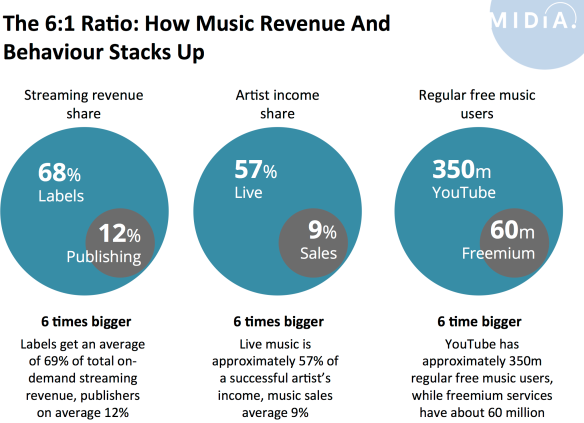The Music Industry’s 6:1 Ratio
One of the many things that the digital revolution has done to the music industry is to create and accentuate a number of imbalances. Imbalances that will either change, become the foundations of the next era of the music business, or both.
Guest Post by Mark Mulligan on Music Industry Blog
In fact there are three key areas where, coincidentally, the lesser party is 6 times smaller than the other:
- Digital music revenue share: A common refrain from songwriters and the bodies that represent them (music publishers, collection societies etc.) is that everything starts with the song. And of course it does. However it is the recorded version of the song that most people interact with most of the time, whether that be on the radio, on a CD, a download, a stream or a music video. This has helped ensure that record labels – usually the owners of the recorded work – hold the whip hand in licensing negotiations with digital music services. Labels have consequently ended up with an average of 68% of total on-demand streaming revenue and publishers / collection societies just 12%. The labels’ share is 6 times bigger. Publishers are now actively trying to rebalance the equation, often referred to as ‘seeking out a fair share’. For semi-interactive radio services like Pandora where labels do not license directly and statutory rates are used instead, the ratio is roughly 2:1.
- Artist income: While music sales declined over the last 10 yeas, live boomed. And although there are signs the live boom may be slowing, a successful artist can now typically expect to earn as little as 9% of their total income from recorded music, compared to 57% from live. Again, a factor of 6:1. There are many complexities to the revenue split, such as the respective deals an artist is on, fixed costs etc. but these splits tend to recur. Ironically just as everything starts with the song for digital music, everything starts with the recorded work (and the song) for the live artist. The majority of an artist’s fan base will spend most of their time interacting with the recorded work of the artist rather than live. The recorded work has become the advert for live. In fact the average concert ticket of a successful frontline artist costs on average 8 times more than buying their entire back catalogue. Thus for fans the ratio is even more pronounced at 8:1.
- Free music users: The freemium wars are dominating the contemporary music industry debate. Spotify and other services that have on demand free tiers are under intense scrutiny over how these tiers may be cannibalising music sales. However YouTube’s regular free music user base is about 350 million compared to approximately 60 million free freemium service users across all freemium services. Again a ratio of 6:1. Whatever the impact freemium users may be having, it is 6 times less than YouTube.
The music industry has never been a meritocracy nor will it ever be one. So it would be fatuous to suggest equality is suddenly going to break out. However there will be something of a righting process in some areas, especially in the digital music revenue share equation. Most significantly though, these ratios are becoming the foundational dynamics of the new music industry. These are the reference points that artists, rights holders, and all other music industry stakeholders need in order to understand what their future will look like and how they can help shape it.
